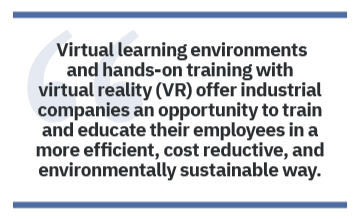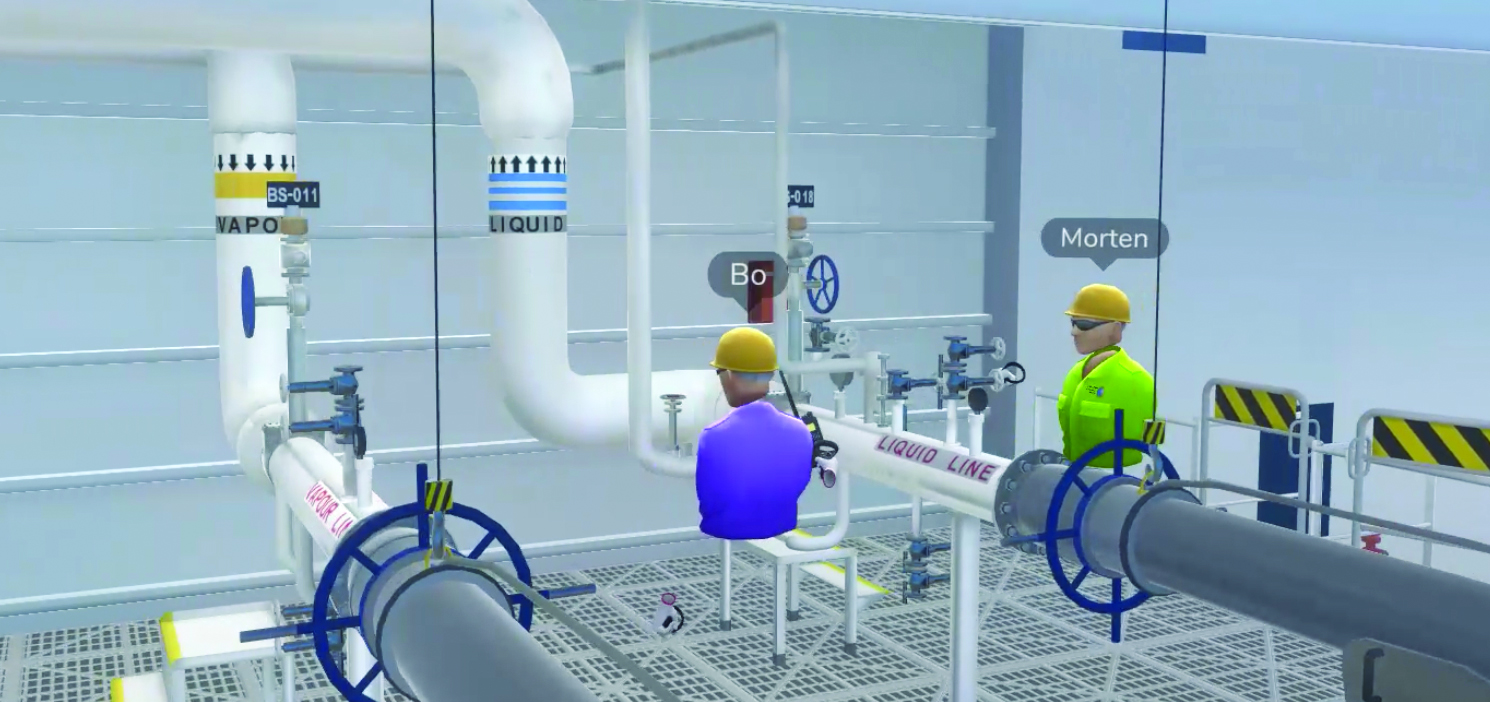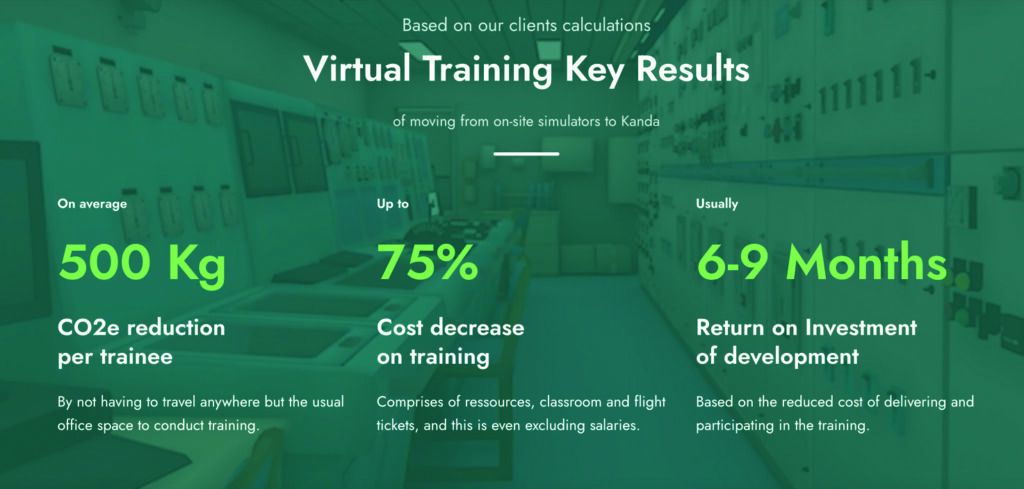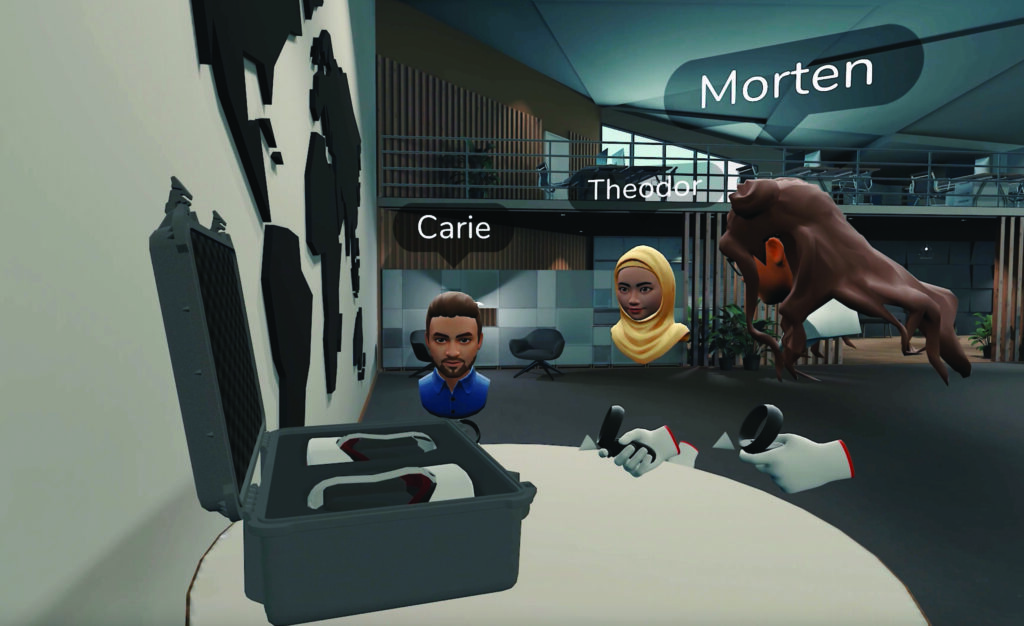By Lene Thirup
Unleashing the potential of virtual reality will revolutionize traditional hands-on training in complex industries.
We know that many of the societal challenges we are facing today will have to be solved by sustainable technologies and innovations in our complex industries. However, within the renewable energy sector alone we need to employ 26 million more people by 2030 if we are to reach the ambition to limit the global warming to 1.5 degrees Celsius.1
The question is who will install, maintain, and repair all the industrial solutions, we rely on — and how will we effectively handle the need for training these millions of people? After all, it is expensive to have employees travel thousands of kilometers for onsite training, particularly when classroom learning methods have limited output.
 In this context, virtual learning environments and hands-on training with virtual reality (VR) offer industrial companies an opportunity to train and educate their employees in a more efficient, cost reductive, and environmentally sustainable way. Indeed, industry leaders in the maritime, renewable energy, and health sectors are adopting VR as a substitute for traditional learning methods with impressive results.
In this context, virtual learning environments and hands-on training with virtual reality (VR) offer industrial companies an opportunity to train and educate their employees in a more efficient, cost reductive, and environmentally sustainable way. Indeed, industry leaders in the maritime, renewable energy, and health sectors are adopting VR as a substitute for traditional learning methods with impressive results.
While it may look like fun and games, VR training offers opportunities for collaborative, hands-on experiences that build camaraderie and provide the detailed on-the-job training needed in complex industries.
Outdated Learning Methods
There have only been a few changes in training over the last 100 years. To a wide extent, training in industrial companies is still primarily based on classroom learning and expensive replicas. An instructor lectures trainees and hopes that they are listening and will benefit from the single-user experience. But lectures have limited success in building real-world knowledge of complex procedures.
 In comparison, hands-on training onsite delivers better engagement than classroom learning. However, often it comes with a high cost involving travel and access to specialized training centers for familiarization, hands-on practice, and repetition for effective retention of knowledge.
In comparison, hands-on training onsite delivers better engagement than classroom learning. However, often it comes with a high cost involving travel and access to specialized training centers for familiarization, hands-on practice, and repetition for effective retention of knowledge.
For the past ten years, the Danish software company Kanda has specialized in using virtual reality and augmented reality in educational contexts. Today, they have developed a virtual reality training platform with the objective to educate employees in complex procedures, with a particular focus on the maritime, renewable energy and healthcare sectors.
Is VR effective for Training?
For decades it was unclear how to measure and document the use of VR in the educational process for the needs of modern industries. Recently, several studies have applied comprehensive methodologies that analyze the design, creation, implementation, and evaluation of individual courses implemented in a VR environment to identify significant advantages and disadvantages.2
Many of these documented advantages of using VR technology in educational context are included in the Virtual Training Platform that Kanda has developed.
Spacing Lessons Out Increases Long-Term Learning
An important aspect of virtual training is the possibility for employees to take their time, learn at their own pace, and repeat the training as many times as necessary
Traditionally, training is frontloaded when employees start; they are exposed to intense amounts of learning in a short period of time. Because of the high cost of on-site training, they rarely have enough time to build familiarity and practice their new skills.
A virtual training platform allows trainees to see, talk, and work together as a team, no matter where in the world they are. They can learn what they need to know in an environment that supports exploration and failure, improving long-term knowledge retention. They can review the material at their leisure to refresh their memory, and easily re-certify as needed.3
Designing Content for Hands-On Training
Yet another advantage of virtual reality as a training tool is that it ensures safety of operations and allows organizations to create complex test scenarios and experiments that are difficult to implement in a real-world setting.
The instructional design of the training content may include dramatic effects and simulated dangerous situations due to failures or mismanagement of procedures that would not be possible in real life.
In one example, a large shipping company wanted to establish green, technology-driven growth towards becoming the preferred transport provider in the shipping industry. VR training is one of the key elements towards that goal. A specially created VR training course has been used to train and certify over 200 crew members on a complete 3D-rendered virtual ship. The main element in the course is to train the complex procedures around handling liquefied natural gas (LNG), which the company often transports. It is a risky process, and thus it is pivotal that all employees are familiar with these procedures when they enter the ship in real life.
With each avatar, the trainees work together to solve different tasks and get used to how the collaboration works in the different procedures on the ship. But they also learn what not to do.
An error in the procedures can result in the pumping equipment exploding with such dramatic effects that trainees will not forget that the error could in fact have had fatal consequences in real life.
When this happens, the participants will start all over again with the review of the training material and making sure that everyone will be able to handle the procedures with LNG correctly. For the maritime industry, this translates into safer and more accessible training for seafarers and other maritime personnel. This high-stakes training can be approached in a way that’s immersive and engaging, yet still shows the serious consequences of errors.
Collaboration is key
Virtual learning environments also promote team collaboration without the need for physical travel to the same location or risk of virus transmissions considering the ongoing pandemic.
Virtual training platforms allow up to 15 colleagues to communicate and collaborate on the complex procedures while being physically situated in different parts of the world. The social aspect is one of the reasons why VR technology is so groundbreaking in this area. Participating in a training session requires nothing more than a pair of VR glasses, a laptop, or a tablet, yet it brings familiarity with both teammates and procedures.
The future of certified training will be digital
VR training can be so detailed and precise that there is no legal difference between the certificates obtained from Kanda VR training and those that come with a physical training with an instructor. The virtual simulated training can be certified to the same industrial standards as traditional physical simulations.
From a learning perspective, virtual training has a huge potential — either as a supplement to classroom training or a complete substitution of physical onsite learning facilities. With accelerated adoption due to the pandemic, it is expected that up to 50 percent of the market can be replaced by digital solutions.
In 2023 Kanda expects to be able to present a “low-code” function on the virtual training platform, which allows customers to design their own training courses and thus introducing even more tailormade learning environments to fulfill specific objectives.
Based on the business case and the documented scientific advantages of using VR technology in education, Kanda plans to continually evolve education and training through immersive digital simulation methods and expand to several other industries.
VR: Environmentally Friendlier and More Cost-Effective
Onsite training for heavy industries is both financially and environmentally costly. By replicating training sites in VR, it is possible to reduce the manufacturing and energy costs associated with building, maintaining, and upgrading training equipment. A VR training platform can reduce the environmental impacts of trainee travel.
Looking into the current key results based on client calculations, the business case looks very promising in terms of moving from onsite to virtual training.
 Virtual training is also cost effective. In addition to reducing the expenses for travel and accommodation for training, they can potentially save millions in asset maintenance previously spent to develop custom-built training sites.
Virtual training is also cost effective. In addition to reducing the expenses for travel and accommodation for training, they can potentially save millions in asset maintenance previously spent to develop custom-built training sites.
The VR Opportunity
 The future for immersive and human-centered digital learning looks strong. We have already seen in Paul Milliman’s article on page 16 that gamification principles can enhance learning. By leveraging VR technology and the engagement that we find in games, it’s possible to develop immersive and human-centered digital learning applications that enable collaborative teamwork from anywhere on the planet.
The future for immersive and human-centered digital learning looks strong. We have already seen in Paul Milliman’s article on page 16 that gamification principles can enhance learning. By leveraging VR technology and the engagement that we find in games, it’s possible to develop immersive and human-centered digital learning applications that enable collaborative teamwork from anywhere on the planet.
References
- International Renewable Energy Agency, IRENA, 2021, IRENA, 2021
- Paszkiewicz, Andrzej, et al. 2021. “Methodology of Implementing Virtual Reality in Education for Industry 4.0.” Sustainability 13, no. 9. https://doi.org/10.3390/su13095049
- Vlach, Haley A., and Catherine M. Sandhofer. 2012. Distributing Learning Over Time: The Spacing Effect in Children’s Acquisition and Generalization of Science Concepts.” Child Development 83, no. 4. https://www.ncbi.nlm.nih.gov/pmc/articles/PMC3399982/

LENE THIRUP (ltj@kanda.dk) is business developer director at Kanda with 20 years of experience as a trusted advisor, collaborating with industry leading companies such as Vestas, Grundfos, and Cobham Satcom. She holds a masters in anthropology and media science and serves as a lecturer at Business Academy Aarhus in Denmark in digital strategy, business development, digital marketing, and communication.



